Drosophila brain development: closing the gap between a macroarchitectural and microarchitectural approach
- PMID: 20028843
- PMCID: PMC3950651
- DOI: 10.1101/sqb.2009.74.037
Drosophila brain development: closing the gap between a macroarchitectural and microarchitectural approach
Abstract
Neurobiologists address neural structure, development, and function at the level of "macrocircuits" (how different brain compartments are interconnected; what overall pattern of activity they produce) and at the level of "microcircuits" (how connectivity and physiology of individual neurons and their processes within a compartment determine the functional output of this compartment). Work in our lab aims at reconstructing the developing Drosophila brain at both levels. Macrocircuits can be approached conveniently by reconstructing the pattern of brain lineages, which form groups of neurons whose projections form cohesive fascicles interconnecting the compartments of the larval and adult brain. The reconstruction of microcircuits requires serial section electron microscopy, due to the small size of terminal neuronal processes and their synaptic contacts. Because of the amount of labor that traditionally comes with this approach, very little is known about microcircuitry in brains across the animal kingdom. Many of the problems of serial electron microscopy reconstruction are now solvable with digital image recording and specialized software for both image acquisition and postprocessing. In this chapter, we introduce our efforts to reconstruct the small Drosophila larval brain and discuss our results in light of the published data on neuropile ultrastructure in other animal taxa.
Figures
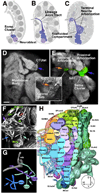
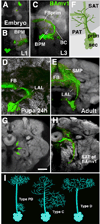


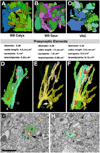
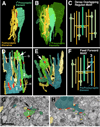
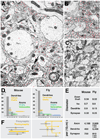

Similar articles
-
An integrated micro- and macroarchitectural analysis of the Drosophila brain by computer-assisted serial section electron microscopy.PLoS Biol. 2010 Oct 5;8(10):e1000502. doi: 10.1371/journal.pbio.1000502. PLoS Biol. 2010. PMID: 20957184 Free PMC article.
-
Neural lineages of the Drosophila brain: a three-dimensional digital atlas of the pattern of lineage location and projection at the late larval stage.J Neurosci. 2006 May 17;26(20):5534-53. doi: 10.1523/JNEUROSCI.4708-05.2006. J Neurosci. 2006. PMID: 16707805 Free PMC article.
-
Arborization pattern of engrailed-positive neural lineages reveal neuromere boundaries in the Drosophila brain neuropil.J Comp Neurol. 2009 Nov 1;517(1):87-104. doi: 10.1002/cne.22112. J Comp Neurol. 2009. PMID: 19711412 Free PMC article.
-
The development of the Drosophila larval brain.Adv Exp Med Biol. 2008;628:1-31. doi: 10.1007/978-0-387-78261-4_1. Adv Exp Med Biol. 2008. PMID: 18683635 Review.
-
Beyond counts and shapes: studying pathology of dendritic spines in the context of the surrounding neuropil through serial section electron microscopy.Neuroscience. 2013 Oct 22;251:75-89. doi: 10.1016/j.neuroscience.2012.04.061. Epub 2012 May 1. Neuroscience. 2013. PMID: 22561733 Free PMC article. Review.
Cited by
-
As-rigid-as-possible mosaicking and serial section registration of large ssTEM datasets.Bioinformatics. 2010 Jun 15;26(12):i57-63. doi: 10.1093/bioinformatics/btq219. Bioinformatics. 2010. PMID: 20529937 Free PMC article.
-
Identification and analysis of a glutamatergic local interneuron lineage in the adult Drosophila olfactory system.Neural Syst Circuits. 2011 Jan 26;1(1):4. doi: 10.1186/2042-1001-1-4. Neural Syst Circuits. 2011. PMID: 22330097 Free PMC article.
-
A high-level 3D visualization API for Java and ImageJ.BMC Bioinformatics. 2010 May 21;11:274. doi: 10.1186/1471-2105-11-274. BMC Bioinformatics. 2010. PMID: 20492697 Free PMC article.
-
Structure of the central nervous system of a juvenile acoel, Symsagittifera roscoffensis.Dev Genes Evol. 2010 Sep;220(3-4):61-76. doi: 10.1007/s00427-010-0328-2. Epub 2010 Jun 15. Dev Genes Evol. 2010. PMID: 20549514 Free PMC article.
-
Developmental analysis of the dopamine-containing neurons of the Drosophila brain.J Comp Neurol. 2017 Feb 1;525(2):363-379. doi: 10.1002/cne.24069. Epub 2016 Jul 11. J Comp Neurol. 2017. PMID: 27350102 Free PMC article.
References
-
- Alon U. Network motifs: theory and experimental approaches. Nat. Rev. Genet. 2007;8:450–461. - PubMed
-
- Baas PW, Yu W. A composite model for establishing the microtubule arrays of the neuron. Mol. Neurobiol. 1996;12:145–161. - PubMed
-
- Braitenberg V, Schüz A. Cortex: Statistics and Geometry of Neuronal Connectivity. 2nd. Springer: Berlin Heidelberg; 1998.
-
- Brand AH, Perrimon N. Targeted gene expression as a means of altering cell fates and generating dominant phenotypes. Development. 1993;118:401–415. - PubMed
Publication types
MeSH terms
Grants and funding
LinkOut - more resources
Full Text Sources
Molecular Biology Databases
Miscellaneous
